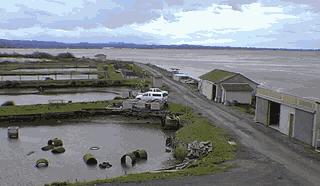No edit summary |
No edit summary |
||
| Line 5: | Line 5: | ||
== Wastewater Aquaculture History == | == Wastewater Aquaculture History == | ||
In the early 1960's Dr. George H. Allen, a professor at HSU, proposed to build the first recirculating salmonid hatchery in the United States.He went on to become a specialist in wastewater aquaculture and teamed closely with the community to develop the Arcata Wastewater Aquaculture Project, which demonstrated the raising of salmon and cutthroat trout fry in a mixture of municipal wastewater and bay water.<ref> Fisheries Dedication Honors Allen, Scott. The Eureka Reporter. April 27,2008. Accessed on 10/21/08.http://www.eurekareporter.com/article/080427-fisheries-dedication-honors-allen-scott</ref> In 1971 the aquaculture ponds were built in the north arm of Humboldt Bay. In the past, wastewater had never been used for salmonids due to there sensitivity to ammonia. With the incorporation of seawater, the ammonia's effect on the salmon was buffered.<ref name="David">Leonhardt, David. Evaluation of a Two Unit Wastewater-Seawater Pond System for Rearing of Juvenile Coho Salmon, Oncorhynchus Kisutch. Thesis presented to HSU. Arcata, CA 1984</ref> | [[Image:Aquaculture1.jpg|left|Figure 1. Arcata's Aquaculture Facility, photo courtesy of HSU's Fisheries Department]] | ||
In the early 1960's Dr. George H. Allen, a professor at HSU, proposed to build the first recirculating salmonid hatchery in the United States.He went on to become a specialist in wastewater aquaculture and teamed closely with the community to develop the Arcata Wastewater Aquaculture Project, which demonstrated the raising of salmon and cutthroat trout fry in a mixture of municipal wastewater and bay water.<ref> Fisheries Dedication Honors Allen, Scott. The Eureka Reporter. April 27,2008. Accessed on 10/21/08.http://www.eurekareporter.com/article/080427-fisheries-dedication-honors-allen-scott</ref> In 1971 the aquaculture ponds were built in the north arm of Humboldt Bay. In the past, wastewater had never been used for salmonids due to there sensitivity to ammonia. With the incorporation of seawater, the ammonia's effect on the salmon was buffered.<ref name="David">Leonhardt, David. Evaluation of a Two Unit Wastewater-Seawater Pond System for Rearing of Juvenile Coho Salmon, Oncorhynchus Kisutch. Thesis presented to HSU. Arcata, CA 1984</ref> | |||
== Research Done == | == Research Done == | ||
Over the years, Professor Allen and students in the [http://www.humboldt.edu/~fish/programs/wastewaterhistory.html/ fisheries department] at HSU. In 1981, David Leonhardt conducted his master's thesis regarding the effectiveness of two interconnected waste water/sea water ponds for rearing salmon smolts. Fingerling coho salmon were raised at the Arcata Aquaculture Facility (AAF)and the Humboldt State University Hatchery. David concluded the smolts raised at the AAF showed higher survival, beter growth, higher percentage of smoltification, and a higher return rate than the salmon raised at the HSU hatchery.<ref name="David"/> | Over the years, Professor Allen and students in the [http://www.humboldt.edu/~fish/programs/wastewaterhistory.html/ fisheries department] at HSU. In 1981, David Leonhardt conducted his master's thesis regarding the effectiveness of two interconnected waste water/sea water ponds for rearing salmon smolts. Fingerling coho salmon were raised at the Arcata Aquaculture Facility (AAF)and the Humboldt State University Hatchery. David concluded the smolts raised at the AAF showed higher survival, beter growth, higher percentage of smoltification, and a higher return rate than the salmon raised at the HSU hatchery.<ref name="David"/> | ||
Revision as of 19:19, 28 October 2008
General History
In a basic sense, aquaculture is the cultivation of marine or fresh water organisms in a controlled environment for scientific or buisness purposes.[1] A number of different kinds of marine life are culitvated all over the world, including oysters, clams, salmon, and trout. Aquaculture can be practiced as a low-technology extensive method to highly intensive system, with varying degrees of each.[1] Extenstive methods do not envolve a lot of change to the natural environment where the cultivation takes place and yield is usually low. On the other hand, intensive systems control many of the variables involved by cultivating the organisms in tanks or man-made ponds and this method usually produces a high yield.
Wastewater Aquaculture History

In the early 1960's Dr. George H. Allen, a professor at HSU, proposed to build the first recirculating salmonid hatchery in the United States.He went on to become a specialist in wastewater aquaculture and teamed closely with the community to develop the Arcata Wastewater Aquaculture Project, which demonstrated the raising of salmon and cutthroat trout fry in a mixture of municipal wastewater and bay water.[2] In 1971 the aquaculture ponds were built in the north arm of Humboldt Bay. In the past, wastewater had never been used for salmonids due to there sensitivity to ammonia. With the incorporation of seawater, the ammonia's effect on the salmon was buffered.[3]
Research Done
Over the years, Professor Allen and students in the fisheries department at HSU. In 1981, David Leonhardt conducted his master's thesis regarding the effectiveness of two interconnected waste water/sea water ponds for rearing salmon smolts. Fingerling coho salmon were raised at the Arcata Aquaculture Facility (AAF)and the Humboldt State University Hatchery. David concluded the smolts raised at the AAF showed higher survival, beter growth, higher percentage of smoltification, and a higher return rate than the salmon raised at the HSU hatchery.[3]
Success in the Project
Current Status
References
- ↑ 1.0 1.1 Answers. Accessed 10/18/08. http://www.answers.com/topic/aquaculture
- ↑ Fisheries Dedication Honors Allen, Scott. The Eureka Reporter. April 27,2008. Accessed on 10/21/08.http://www.eurekareporter.com/article/080427-fisheries-dedication-honors-allen-scott
- ↑ 3.0 3.1 Leonhardt, David. Evaluation of a Two Unit Wastewater-Seawater Pond System for Rearing of Juvenile Coho Salmon, Oncorhynchus Kisutch. Thesis presented to HSU. Arcata, CA 1984
<layout name="Project" />